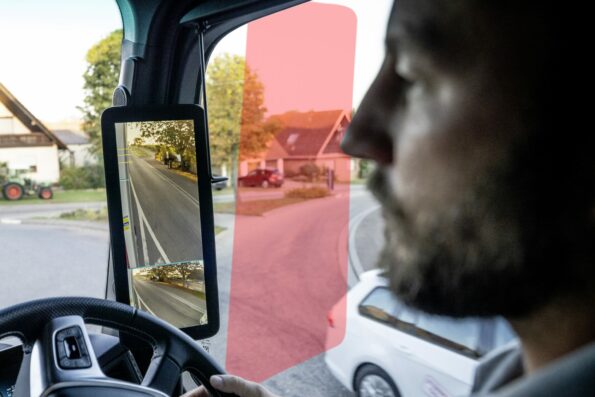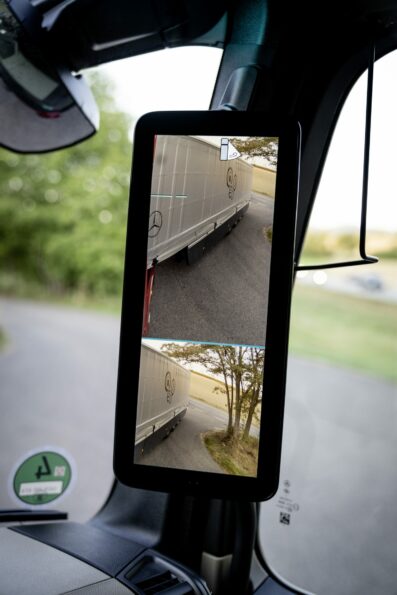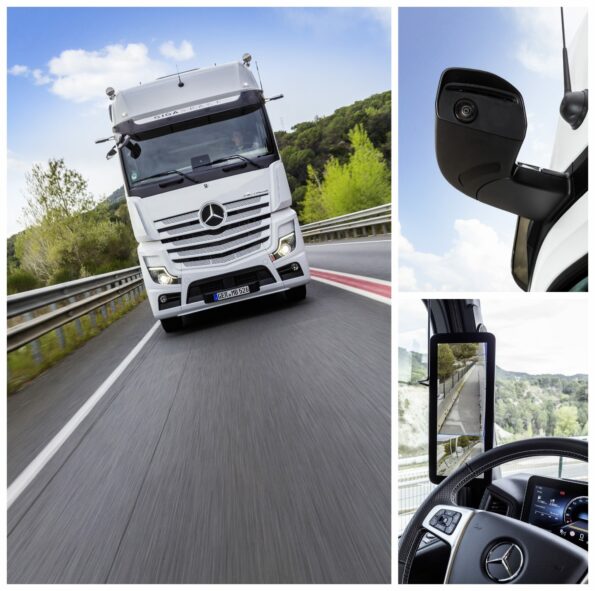We talked about blind spots on trucks and buses and how they leave huge gaps that can hide other road users. Some new technology that helps reduce blind spots for trucks is mirror cameras. Under UN Regulation 46, which Australia adopted in 2014, it’s possible for vehicles to be sold with mirror cameras, but adoption has been slow. Mercedes will sell you an Actros with its proprietary MirrorCam system, but good luck finding many others that aren’t aftermarket systems – at the time of writing, Scania, DAF, Volvo and UD were not offering a similar system.
Has Mercedes jumped the gun or stolen a march on its competitors? Let’s look at the advantages and disadvantages of using cameras instead of rear-view mirrors.
Camera wing mirror advantages
Removing the wing mirrors removes a huge blind spot that makes it hard for drivers to see smaller road users like motorcyclists and cyclists when approaching an intersections, or pedestrians waiting at a crossing.

Taking the side mirrors away reduces drag. Mercedes estimates fuel savings of up to 1.3% (presumably at highway speeds when drag is more of a factor). This is significant on a long run.
The camera screens are inside the cab, on the A-pillar, as shown above. This means they are not subject to grime, spider webs, dust, condensation and rain – the view is consistent. The camera in the MirrorCam system is small and mounted high, has a built-in heater and is easy to clean.
Cameras can adjust to low light levels and provide an enhanced image giving the driver a better view at night, and it can reduce the glare from headlights.
If you use two or more drivers, or you’re pulling a variety of trailers, systems can store different preferences that remember settings.
As the display is a video display, graphical overlays can be used to help the driver make decisions, such as lines that represent distances. Expect that these kinds of systems will get more intelligent over time, possibly even helping the driver align perfectly when reversing. The MirrorCam system can work in with other Mercedes safety products to warn of other vehicles next to the truck.
The mirrors can automatically adjust for different scenarios, such as trailer off-tracking when turning tight bends (i.e. to keep the rear of the trailer in view at all times), for reversing and for precise alignment alongside another object (for example when offloading a container). There is a guide to setting up MirrorCam with multi-combinations.

The passenger sees the same view down the side of the truck as the driver, meaning they can be more engaged with what is going on.
If the driver suspects that someone is tampering with the truck when parked up at night, they can turn on the camera view to verify it. Presumably at some point in the future, options will be available to record footage for security purposes.
Because the screens are located inside the cab, the driver’s head doesn’t need to turn as much to see them. This means that more of the road ahead is visible in the driver’s peripheral vision. For a driver that wears glasses, the frame of the glasses does not interfere as much in the view of the screens vs mirrors.

The camera can warn if the setting is not covering
Camera wing mirror disadvantages
They don’t eliminate all blind spots – drivers still need to be cautious when changing lanes and manoeuvring, and the driver can’t move their head around to quickly expand the view, this has to be done by moving the camera.
Depth perception is difficult on a flat screen, which is why systems use graphical overlays to indicate distance.
Eye contact with other road users is impossible. This can create uncertainty for cyclists and motorcyclists filtering through to the lights.
It’s another electrical system to add complexity for maintenance and repairs. If the camera fails, there is no backup as there’s no side mirror.
It doesn’t remove the need for a downwards-facing convex mirror on the passenger side, or at the front (presumably other cameras could be added to cover these areas, and perhaps sensors, too).
Drivers need a short time to acclimatise to using the mirrors, plus some training in how to set them up.
Should you drive a truck with mirror cameras?
The fuel savings alone could add a few hundred dollars a year to a truck’s profit – maybe more, depending on the kilometres driven and what type of driving. This also reduces CO2 emissions.
The security aspect is touted as being beneficial for drivers who are worried about fuel or goods being stolen while they’re asleep.
This technology may make it easier to manoeuvre once the driver is used to it.
